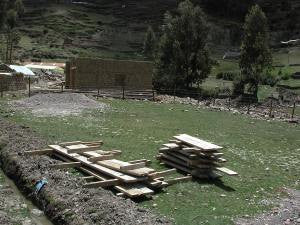The famous images of indigenous women weaving against a stunning mountain backdrop are very eye catching and appealing. However the reality is working outside is not that enjoyable, especially in the wet season, which lasts 4 -5 months of the year starting in November and continuing through with greater intensity to peak in February.
The wet season months are also typically low season for tourists, and so as most of the supplementary income for the communities which comes from the men working as muleteers or porters dries up.
Threads of Peru would like to continue to work with the craftswom en during these months, but if the weavings get wet, they stretch and warp. Also, if we make orders during these months we know that the women weave in their houses, which are very dark even during the day. There is no electricity so weaving during the night is out of the question. It is so dark in the houses that their eyes suffer significant strain, and as most houses do not have a chimney they fill up quickly with smoke damaging the quality of the weaving and, more importantly, the health of the weaver.
en during these months, but if the weavings get wet, they stretch and warp. Also, if we make orders during these months we know that the women weave in their houses, which are very dark even during the day. There is no electricity so weaving during the night is out of the question. It is so dark in the houses that their eyes suffer significant strain, and as most houses do not have a chimney they fill up quickly with smoke damaging the quality of the weaving and, more importantly, the health of the weaver.
- Shelter from elements while weaving or meeting in the long wet season
- A meeting place for women
- Place to host visitors to the community and put weavings on display.
- It has potential to be a sheltered campsite for visitors to the community.
There is a temptation amongst foreigners working with these remote villagers to do everything for the community, so we have been waiting for the communities to take the lead on this project and so to encourage sustainability from within.
We are currently working with the community in Rumira Sondormayo who have now organised some land by the river for their weaving house, and fenced it off.
 Furthermore, we have secured funding from some generous Canadian donors (who have trekked with our partners Apus Peru two years running) who will assist in the purchase of materials needed and which cannot be obtained in the community.
Furthermore, we have secured funding from some generous Canadian donors (who have trekked with our partners Apus Peru two years running) who will assist in the purchase of materials needed and which cannot be obtained in the community.
All manual labour needed to construct the Rumira Sondormayo weaving house will be from the community, in keeping with the traditional principle of ayni.
We hope to post pictures of this shelter very soon!

